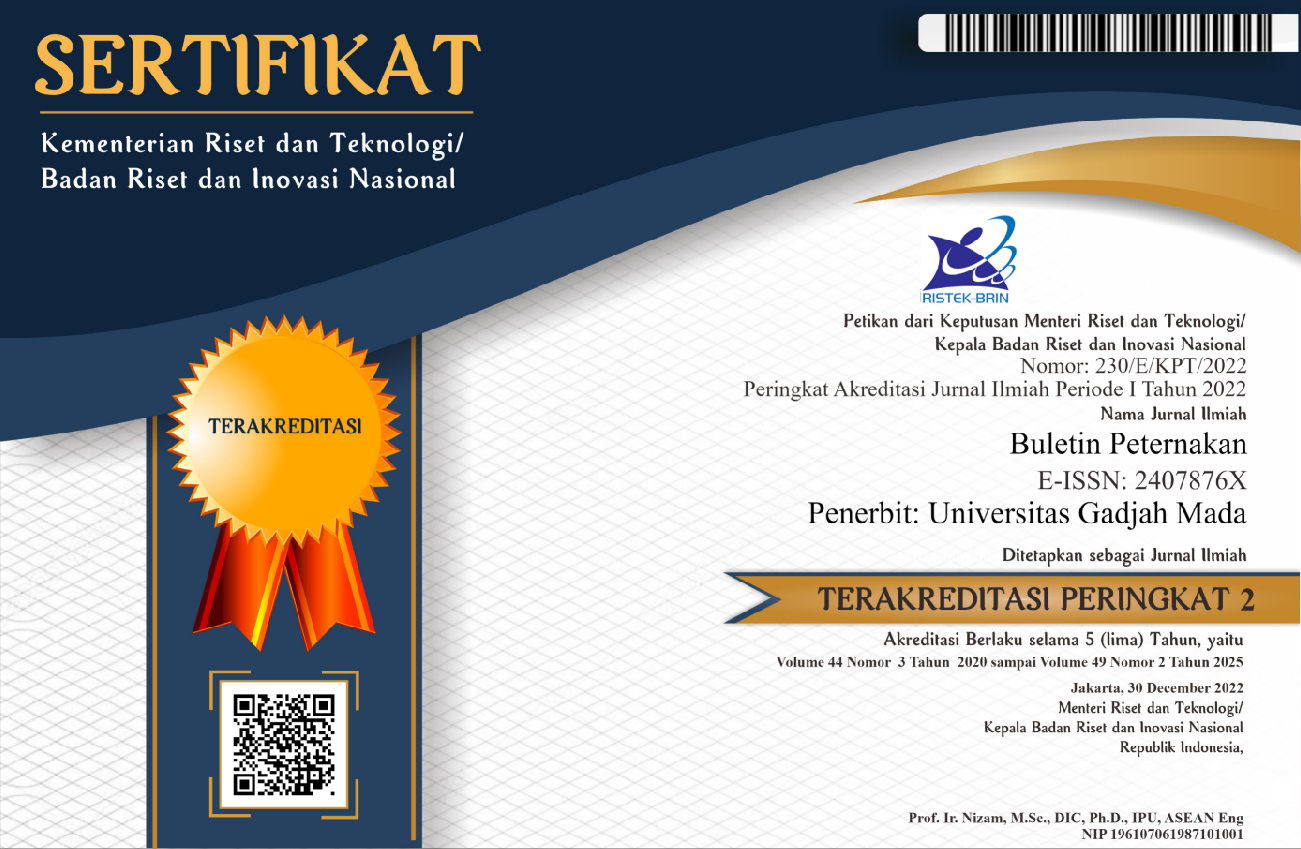Pertumbuhan Kompensasi Ayam Betina Hasil Persilangan Antara Ayam Kampung Jantan Dengan Ayam Ras Petelur Betina Yang Mendapat Level Protein Pakan Masa Starter Berbeda
Harimurti Februari Trisiwi(1*)
(1) Akademi Peternakan Brahmaputra
(*) Corresponding Author
Abstract
The experiment was conducted to examine the effect of various dietary protein levels during starting period (0-9 weeks) on compensatory growth period (9-12 weeks) of crossbred hens between cockerel native chicken and laying hens. Thirty two day old chicks were randomly divided into four different groups. For the first 9 weeks, each groups were fed with four different treatments : P1 type with 21,13% dietary protein, P2 type with 18,71% dietary protein, P3 type with 16,58% dietary protein, and P4 type with 14,79% dietary protein. At 9 weeks of age, each treatment group were then divided into 4 replications. The all chickens were then fed with P1 type feed until the end of the experiment during compensatory growth period. The variables observed were consumption (feed, protein, energy), the final body weight, the weight gain, the feed conversion, the protein efficiency ratio, and the energy efficiency ratio. The collected data were analysed using the one-way classification of variance analysis (CRD), followed by testing the significant means using The Duncan’s Multiple Range Test (DMRT). The result showed that the various dietary protein during the starting period did not cause significant differences on feed consumption during the compensatory growth period. The consumption of the P3 type and the P4 type feed during the starting period resulted a better weight gained and feed conversion during compensatory growth period than the use of the P1 type. The highest compensatory growth was achieved by the treatment group with the P3 type feed, as there was no significant difference of the chicken’s final body weight compared to chickens being fed with higher protein percentage (21,13%). There was also no significant difference of the protein and energy consumption among the treatment groups. Protein efficiency ratio and energy efficiency ratio of chicken fed with P3 and P4 type of feed are better than those fed with a higher dietary protein level. In conclution crossbred hens fed with high protein level (more than 18.71%) did not significantly affected on the weight gain and the final body weight during 9 to 12 weeks of rearing.
Keywords
Full Text:
PDF (Bahasa Indonesia)References
Astuti, M. 1980. Rancangan Percobaan dan Analisis Statistik. Bagian Pemuliaan Ternak, Fakultas Peternakan UGM. Yogyakarta.
Azis, A., A. Abbas, Y. Heryandi, dan E. Kusnadi. 2011. Pertumbuhan Kompensasi dan Efisiensi Produksi Ayam Broiler yang Mendapat Pembatasan Waktu Makan. Media Peternakan April 2011 : 50-57.
Haryadi, F. T. dan Wihandoyo. 2005. Studi Kelayakan Ekonomi dan Produksi Pemanfaatan Pakan Pengisi dan Phenomena Compensatory Growth pada Peternakan Ayam Pedaging. Buletin Peternakan Vol. 29(1) : 26-34.
Kompiang, I. P., Supriyati, M. H. Togatorop, dan S. N. Jarmani. 2001. Kinerja Ayam Kampung dengan Sistem Pemberian Pakan secara Memilih dengan Bebas. Jurnal Ilmu Ternak dan Veteriner Vol. 6 (2) : 94-101.
Maryanto, Hardjosworo, P. S., Herman R., dan Setijanto H. 2002. Evaluasi Karkas Hasil Persilangan antara Ayam Kampung Jantan dengan Ayam Ras Petelur Betina. Animal Production Vol. 4 (2) : 71-76.
Rumiyani, T., Wihandoyo, dan J. H. P. Sidadolog. 2011. Pengaruh Pemberian Pakan Pengisi pada Ayam Broiler Umur 22-28 Hari terhadap Pertumbuhan dan Kandungan Lemak Karkas dan Daging. Buletin Peternakan Vol. 35 (1) : 38-49.
Saleh, E. A., S. E. Watkins, and P. W. Waldroup. 1996. High-Level Usage of Dried Product in Broiler Diets. J. Appl. Poult. Sci. Res. 5 : 33-38.
Salim, E. 2013. Ayam Kampung Super. Lily Publisher. Yogyakarta.
Sasongko, H. 1989. Kemampuan Pertumbuhan Kompensatorik pada Ayam Kampung. Buletin Peternakan Vol. 13 (1) : 26-30.
Soeparno. 1992, Ilmu dan Teknologi Daging. Gadjah Mada University Press. Jakarta.
Suci, D. M., L. Rosaline, dan R. Mutia. 2005. Evaluasi Penggunaan Tepung Daun Pisang pada Periode Starter untuk Mendapatkan Pertumbuhan Kompensasi Ayam Broiler. Media Peternakan Vol. 28 (1) : 21-28.
Trisiwi, H. F. 2004. Pengaruh Level Protein dengan Koreksi Asam Amino Esensial dalam Pakan terhadap Penampilan dan Nitrogen Ekskreta Ayam Kampung. Buletin Peternakan Vol. 28 (3) : 131-141.
Tolkamp, B. J., V. Sandilands, and I. Kyriazakis. 2005. Effects of Qualitative Feed Restriction on the Performance of Broiler Breeders During Rearing and Lay. J. Poult. Sci. 84 : 1286-1293.
Zhan, X. A., M. Wang, H. Ren, R. Q. Zhao, J. X. Li, and Z. L. Tan. 2007. Effect of Early Feed Restriction on Metabolic Programming andcompensatory Growth in Broiler Chickens. Poult. Sci. 86 : 654-660.
Article Metrics
Refbacks
- There are currently no refbacks.
License URL: http://journal.ugm.ac.id/buletinpeternakan/pages/view/Publication%20Ethics%20and%20Malpractice%20Statement
Buletin Peternakan (Bulletin of Animal Science) Indexed by:

This work is licensed under a Creative Commons Attribution-ShareAlike 4.0 International License.









